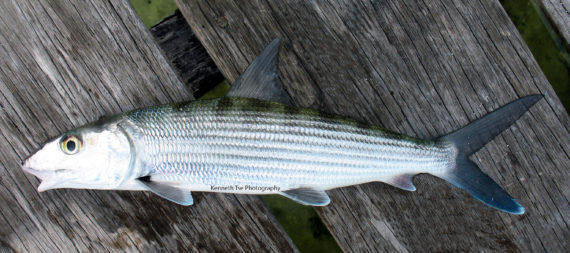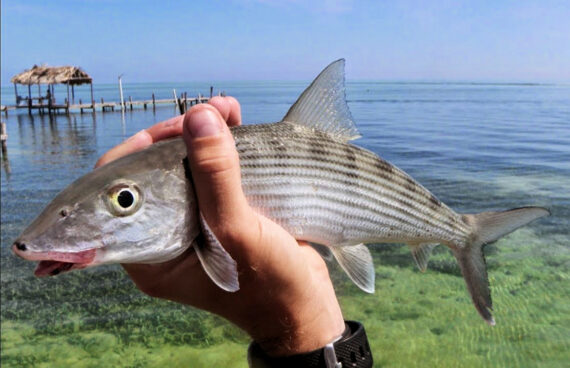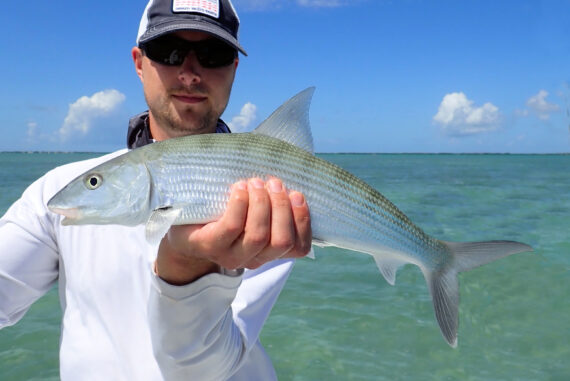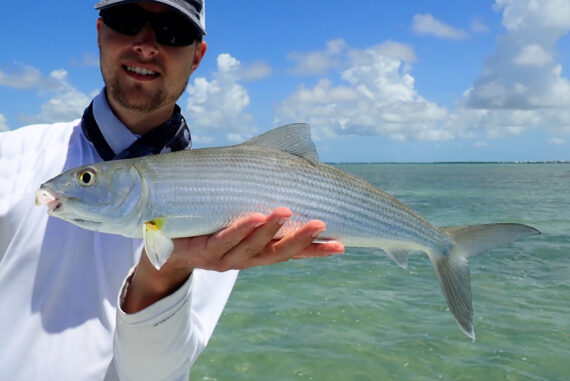Bonefish, Albula vulpes
 Bonefish, Albula vulpes. Fish caught from coastal waters off Caye Caulker, Belize, June 2013. Length: 30 cm (12 inches). Catch, photograph, and identification courtesy of Kenneth Tse, Toronto, Canada.
Bonefish, Albula vulpes. Fish caught from coastal waters off Caye Caulker, Belize, June 2013. Length: 30 cm (12 inches). Catch, photograph, and identification courtesy of Kenneth Tse, Toronto, Canada.
 Bonefish, Albula vulpes. Fish caught from coastal waters off Tobacco Caye, Belize, October 2012. Length: 32 cm (13 inches). Catch, photograph, and identification courtesy of Josh Leisen (joshadventures.com), Gaylord, Michigan.
Bonefish, Albula vulpes. Fish caught from coastal waters off Tobacco Caye, Belize, October 2012. Length: 32 cm (13 inches). Catch, photograph, and identification courtesy of Josh Leisen (joshadventures.com), Gaylord, Michigan.
 Bonefish, Albula vulpes. Fish caught from coastal waters off Caye Ambergris, Belize, June 2013. Length: 36 cm (14 inches). Catch, photograph and identification courtesy of Eli (obsessiveangling.wordpress.com).
Bonefish, Albula vulpes. Fish caught from coastal waters off Caye Ambergris, Belize, June 2013. Length: 36 cm (14 inches). Catch, photograph and identification courtesy of Eli (obsessiveangling.wordpress.com).
 Bonefish, Albula vulpes. Fish caught from coastal waters off Islamorada, Florida, June 2021. Length: 72 cm (2 feet 4 inches). Catch, photograph and identification courtesy of Ben Cantrell, Sebastian, Florida. Note the interesting yellow color at the base of the pectoral fin in the second photo posted above.
Bonefish, Albula vulpes. Fish caught from coastal waters off Islamorada, Florida, June 2021. Length: 72 cm (2 feet 4 inches). Catch, photograph and identification courtesy of Ben Cantrell, Sebastian, Florida. Note the interesting yellow color at the base of the pectoral fin in the second photo posted above.
 Bonefish, Albula vulpes. Fish caught from coastal waters off Islamorada, Florida, June 2021. Length: 74 cm (2 feet 5 inches). Catch, photograph and identification courtesy of Ben Cantrell, Sebastian, Florida. Note the interesting yellow color at the base of the pectoral fin versus the fish above.
Bonefish, Albula vulpes. Fish caught from coastal waters off Islamorada, Florida, June 2021. Length: 74 cm (2 feet 5 inches). Catch, photograph and identification courtesy of Ben Cantrell, Sebastian, Florida. Note the interesting yellow color at the base of the pectoral fin versus the fish above.
The Bonefish, Albula vulpes, is a member of the Bonefish or Albulidae Family, and is known in Mexico as macabí. Globally, there are only six species in the genus Albula, of which four are found in Mexican waters, one in the Atlantic and three in the Pacific Ocean.
The Bonefish is a relatively small fish with long, slender, round, and slightly compressed body. They are greenish-blue dorsally and transition to silvery ventrally with dark longitudinal streaks on their sides. Their caudal and dorsal fins have dusky margins. Juveniles have a series of 9 dark crossbands on their back. Their dorsal profile is more convex than the ventral profile. Their fins have no spines. Their anal fin has a short base and 8 or 9 rays and is set well behind the dorsal fin; their caudal fin is deeply forked with the upper lobe slightly larger than the lower lobe; their dorsal fin is found mid-body; it has a short base with 17 or 18 rays and is triangularly-shaped and significantly elevated; and, their pectoral fins are low on the body and their pelvic fins are on the abdomen well behind the pectoral fins. Their head is conical with a small, short, inferior mouth that does not reach the eyes and a pointed overhanging snout that is equipped with small granular teeth set in bands designed for grinding prey. They have 16 to 18 gill rakers. They are covered with modest-sized smooth scales. Their lateral line is straight.
The Bonefish is a demersal species that is found in the tropical and subtropical northwest Atlantic within mangroves, seagrasses, and other shallow coastal habitats. They reside at depths up to 52 m (165 feet) and in waters with temperatures below 37oC (99oF). They reach a maximum of 77 cm (31 inches) in length and 6.4 kg (14 lbs 0 oz) in weight. As of January 1, 2024, the International Game Fish Association world record stood at 71 cm (28 inches), with the fish caught in the Cook Islands in September 2016. They are a schooling species found in groups consisting of up to one hundred individuals. They can also be found alone or in pairs. They enter tidal flats on the incoming tide and feed predominantly on benthic invertebrates (bivalves and crabs) and small fish. In turn they are preyed upon by various barracudas and sharks. They rely on speed to avoid predation and are ever vigilant making them difficult to catch by recreational anglers. They spend most of their time in the same areas but are known to migrate up to 225 km (140 miles) to offshore waters for spawning. Sexual maturity is reached within two years. Their eggs and larvae are pelagic with the larval stage being leptocephalic (ribbon-like) and twice as long as the resulting juveniles. They have lifespans of up to twenty years. The Bonefish is poorly studied with very limited information available about their lifestyle and behavioral patterns including specific details on age, growth, longevity, movement patterns, diet, habitat use, and reproduction.
The Bonefish is a resident of all Mexican waters of the Atlantic Ocean including the Gulf of Mexico and the east coast of the Yucatán Peninsula in the Caribbean.
The Bonefish are currently the subject of significant scientific interest. Historically there were thought to be two species, one from the Atlantic and one from the Pacific Ocean. With new molecular genetic information it is now believed that there are nine genetically distinct species that are morphologically indistinguishable. Until this work is completed I will consider the fish that resides in the Atlantic Ocean to be Albula Vulpes. Due to its distinguishing characteristics this fish cannot easily be confused with any other fish from the Atlantic.
From a conservation perspective the Bonefish is currently considered as NEAR THREATENED. In the Florida Keys and around the Yucatán Peninsula they are considered VULNERABLE. In these areas, population declines as high as 90% have been reported in the last fifty years. These declines are attributed to loss of habitat with declines in mangroves, seagrass areas, and coral reefs caused by human influence in coastal waters. They have high site fidelity and therefore are especially vulnerable to habitat fragmentation. They are not well protected and current regulations are poorly enforced. The Bonefish are fairly rare but heavily targeted by recreational fishermen due to their elusiveness and powerful swimming abilities. They are also the focus of subsistence and artisanal fishermen who use handlines, gill nets, and seine nets. They are not deemed a valuable food fish due to the numerous fine bones omnipresent in their flesh and the presence of ciguatoxin. They are used on a limited basis as live bait targeting large pelagic and reef fish such as marlins and groupers.